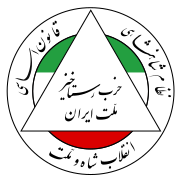| Party of Resurrection of the Iranian Nation حزب رستاخیز ملت ایران | |
|---|---|
 Logo featuring 'Resurrection Party of People of Iran' (center), 'Constitution' (top left), 'Shah–People Revolution' (below), 'Imperial System' (top right) writings in Persian Logo featuring 'Resurrection Party of People of Iran' (center), 'Constitution' (top left), 'Shah–People Revolution' (below), 'Imperial System' (top right) writings in Persian | |
| Founder | Mohammad Reza Pahlavi |
| Founded | 2 March 1975; 49 years ago (2 March 1975) |
| Dissolved | 1 November 1978; 46 years ago (1 November 1978) |
| Merger of | Iranians' Party New Iran Party People's Party |
| Worker wing | Worker House |
| Membership | 5,000,000 (1976 est.) |
| Ideology |
|
| Political position | Big tent (with centre-right to right-wing factions) |
| Part of a series on |
| Conservatism in Iran |
|---|
  |
| Ideologies |
Principles
Principlist groups
Monarchist groups |
| History |
| Intellectuals |
PoliticiansPrinciplists
Monarchists |
Literature
|
PartiesActive
Defunct |
| Organisations |
| Media |
| Related topics |
The Party of Resurrection of the Iranian Nation (Persian: حزب رستاخیز ملت ایران), or simply the Rastakhiz Party (Persian: حزب رستاخیز, romanized: Hezb-e Rastāxiz, lit. 'Resurgence/Resurrection Party'), was Iran's sole legal political party from 2 March 1975 until 1 November 1978, founded by Mohammad Reza Shah.
History

Founded under the government of Prime Minister Amir Abbas Hoveyda, the party has been blamed by some with contributing to the overthrow of the Pahlavi monarchy by antagonizing formerly apolitical Iranians with its compulsory membership and dues (taxes), and general interference in the political, economic, and religious concerns of people's lives.
Established along with the party was a youth wing—Rastakhiz Youth—which Hoveyda referred to as "the instrument of Iran's development". Through this youth wing and a special task force of the party, Rastakhiz embarked upon a large-scale anti-profiteering campaign directed against the bazaari merchants, who were soon identified as "enemies of the state". In October 1975, the Shah, referring to this campaign as a "cultural movement", decreed that anti-profiteerism be made the fourteenth principle of the White Revolution.
The single party system ended in late 1978 as the Iranian Revolution gained ground.
Electoral history
| Election | Party leader | Parliament | Senate | Ref |
|---|---|---|---|---|
| 1975 | Amir-Abbas Hoveyda | 268 / 268 | 30 / 30 | IPU |
Leadership
|
|
See also
References
Notes
- John H. Lorentz (2010). "Rastakhiz Party". The A to Z of Iran. The A to Z Guide Series. Vol. 209. Scarecrow Press. pp. 266–268. ISBN 978-1461731917.
- ^ John H. Lorentz (2010). "Rastakhiz Party". The A to Z of Iran. The A to Z Guide Series. Vol. 209. Scarecrow Press. pp. 266–268. ISBN 978-1461731917.
- ^ Parviz Daneshvar (2016). Revolution in Iran. Springer. p. 73. ISBN 978-1349140626.
- Daryaee, Touraj (2012). The Oxford Handbook of Iranian History. Oxford Handbooks in History. Oxford University Press. p. 361. ISBN 978-0199732159.
- Abrahamian, Ervand (1999). Tortured Confessions: Prisons and Public Recantations in Modern Iran. University of California Press. p. 113. ISBN 9780520216235.
- Abrahamian, Ervand (2008). A History of Modern Iran. Cambridge University Press. p. 153. ISBN 978-0521528917.
- ^ Gholam Reza Afkhami (2008). The Life and Times of the Shah. University of California Press. pp. 434–444. ISBN 978-0-520-25328-5.
The conception of the party, a hybrid of the Italian and Spanish schools of fascism, met with widespread opposition and was withdrawn once the queen sided with its opponents. But then fascism yielded to communism. The organization became principle democratic centralism, though the term was not mentioned.
- ^ Abrahamian, Ervand (1982). Iran Between Two Revolutions. Princeton University Press. pp. 442–446. ISBN 0-691-10134-5.
- Yom, Sean (2015). From Resilience to Revolution: How Foreign Interventions Destabilize the Middle East. Columbia University Press. pp. 142–143. ISBN 9780231540278.
- Middle Eastern Studies, 38 (1), 1 January 2002, pp. 131–168
- ^ Elizabeth Collard (1979), "Iran", MEED, 23, Economic East Economic Digest Ltd: 17
- Milani, Abbas (2008). Eminent Persians: The Men and Women who Made Modern Iran, 1941–1979. Vol. 1. Syracuse, N.Y.: Syracuse University Press. pp. 205–212. ISBN 978-0815609070.
Bibliography
- Amini, P., "A Single Party State in Iran, 1975–78]: The Rastakhiz Party – the Final Attempt by the Shah to Consolidate his Political Base," Middle Eastern Studies, 38 (1) January 2002, pp. 131–168.
Further reading
- Shakibi, Zhand (2018). "The Rastakhiz Party and Pahlavism: the beginnings of state anti-Westernism in Iran". British Journal of Middle Eastern Studies. 45 (2): 251–268. doi:10.1080/13530194.2016.1246242. S2CID 151598124.
- Shakibi, Zhand (2020). Pahlavi Iran and the Politics of Occidentalism: The Shah and the Rastakhiz Party. London: I.B. Tauris. ISBN 978-1-7883-1736-8.
External links
 Media related to Rastakhiz Party at Wikimedia Commons
Media related to Rastakhiz Party at Wikimedia Commons
| Ruling party of Iran | ||
|---|---|---|
| Preceded byNew Iran Party | Resurgence Party 1975–1978 |
VacantTitle next held byIslamic Republican Party |
- Banned far-right parties
- Banned political parties in Iran
- 1975 establishments in Iran
- Political parties established in 1975
- 1978 disestablishments in Iran
- Political parties disestablished in 1978
- Political parties of the Iranian revolution
- Mohammad Reza Pahlavi
- Parties of one-party systems
- Monarchist parties in Iran
- Third Position
- Fascism in Iran
- Anti-communist parties
- Far-right political parties in Iran